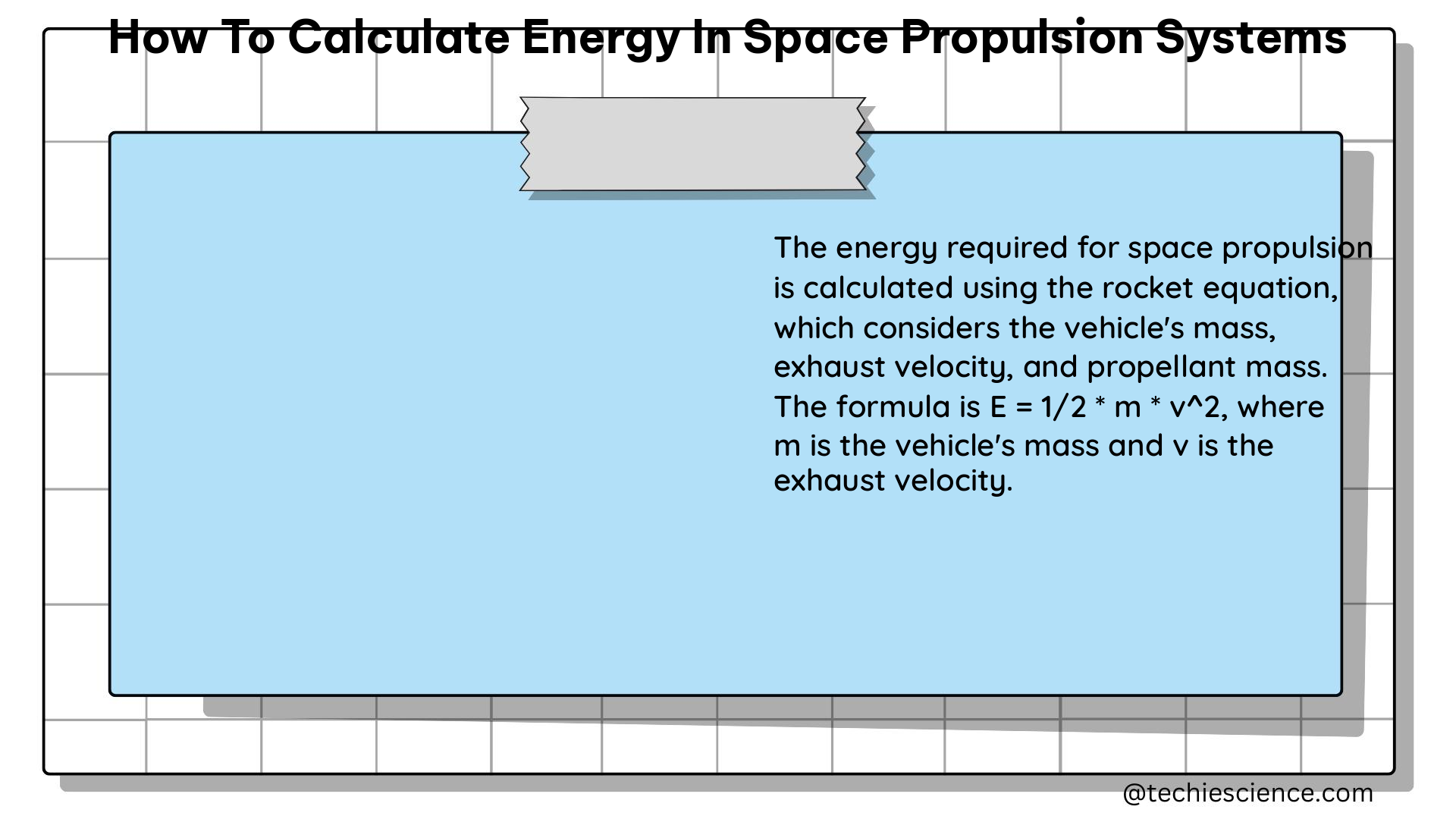Calculating the energy requirements for space propulsion systems is a crucial aspect of spacecraft design and mission planning. This comprehensive guide will provide you with the necessary formulas, parameters, and examples to accurately determine the energy consumption of various space propulsion technologies.
Key Parameters in Energy Calculations
1. Specific Impulse (Isp)
- Specific Impulse (Isp) is a measure of the efficiency of a rocket engine, indicating the amount of thrust produced per unit of propellant consumed.
- The formula for Specific Impulse is:
Isp = F / (ṁ * g0), where: Fis the thrust (in Newtons)ṁis the mass flow rate of the propellant (in kg/s)g0is the standard acceleration due to gravity (9.81 m/s²)- The higher the Isp, the more efficient the engine is in converting propellant into thrust.
2. Thrust (F)
- Thrust is the force produced by the engine, which propels the spacecraft forward.
- The formula for Thrust is:
F = ṁ * ve, where: ṁis the mass flow rate of the propellant (in kg/s)veis the exhaust velocity of the propellant (in m/s)
3. Exhaust Velocity (ve)
- Exhaust velocity is the velocity at which the propellant is expelled from the engine.
- The formula for Exhaust Velocity is:
ve = sqrt((2 * γ * R * T0) / M), where: γis the specific heat ratio of the propellantRis the gas constant (in J/(kg·K))T0is the combustion chamber temperature (in K)Mis the molecular mass of the propellant (in kg/mol)
4. Power (P)
- Power is the energy required to produce the desired thrust.
- The formula for Power is:
P = (F * ve) / 2, for electric propulsion systems.
5. Energy Efficiency (η)
- Energy efficiency is the proportion of input energy that is converted into useful thrust.
- The formula for Energy Efficiency is:
η = (Pthrust / Pinput) * 100, where: Pthrustis the power converted into thrustPinputis the input power to the propulsion system
Example Calculations

- Specific Impulse Calculation:
- Given:
F = 1000 N,ṁ = 0.1 kg/s,g0 = 9.81 m/s² -
Calculated:
Isp = 1000 / (0.1 * 9.81) = 1019.6 s -
Thrust Calculation:
- Given:
ṁ = 0.1 kg/s,ve = 3000 m/s -
Calculated:
F = 0.1 * 3000 = 300 N -
Exhaust Velocity Calculation:
- Given:
γ = 1.2,R = 287 J/(kg·K),T0 = 3000 K,M = 28.97 kg/mol -
Calculated:
ve = sqrt((2 * 1.2 * 287 * 3000) / 28.97) = 2424.5 m/s -
Power Calculation:
- Given:
F = 300 N,ve = 2424.5 m/s -
Calculated:
P = (300 * 2424.5) / 2 = 363,675 W -
Energy Efficiency Calculation:
- Given:
Pthrust = 363,675 W,Pinput = 500,000 W - Calculated:
η = (363,675 / 500,000) * 100 = 72.73%
These examples demonstrate the application of the key formulas and parameters to calculate the energy requirements for various space propulsion systems. By understanding these principles, you can optimize the design and performance of your spacecraft’s propulsion system.
Advanced Considerations
Propellant Selection
The choice of propellant can significantly impact the energy efficiency and performance of a space propulsion system. Some common propellants used in space applications include:
– Chemical propellants (e.g., liquid hydrogen, liquid oxygen, hydrazine)
– Electric propellants (e.g., xenon, krypton, Hall effect thrusters)
– Nuclear thermal propellants (e.g., hydrogen, ammonia)
Each propellant has its own unique properties, such as specific impulse, exhaust velocity, and energy density, which must be carefully considered when designing the propulsion system.
Propulsion System Types
Space propulsion systems can be broadly classified into two main categories:
1. Chemical Propulsion:
– Utilizes the chemical energy stored in the propellants to generate thrust.
– Examples: Liquid rocket engines, solid rocket motors, hybrid rocket engines.
2. Electric Propulsion:
– Uses electrical energy to accelerate the propellant and generate thrust.
– Examples: Ion engines, Hall effect thrusters, electrostatic thrusters.
The energy calculations for these different propulsion system types may vary, and specific formulas and considerations may be required.
Mission-Specific Factors
When calculating the energy requirements for a space propulsion system, it is essential to consider the specific mission requirements, such as:
– Spacecraft mass and size
– Desired acceleration and velocity
– Orbital maneuvers (e.g., launch, orbit insertion, station-keeping)
– Mission duration and propellant consumption
– Payload requirements and constraints
These mission-specific factors can significantly impact the energy calculations and the overall design of the propulsion system.
Conclusion
Calculating the energy requirements for space propulsion systems is a complex and multifaceted process that involves various parameters and formulas. By understanding the key concepts, such as specific impulse, thrust, exhaust velocity, power, and energy efficiency, you can accurately determine the energy needs of your spacecraft’s propulsion system. Additionally, considering advanced factors like propellant selection, propulsion system types, and mission-specific requirements can further refine your energy calculations and optimize the overall performance of your space propulsion system.
References:
– Rocket Propulsion Elements by George P. Sutton and Oscar Biblarz
– Fundamentals of Astrodynamics and Applications by David A. Vallado
– Spacecraft Propulsion by Malcolm Macdonald and Viorel Badescu

The lambdageeks.com Core SME Team is a group of experienced subject matter experts from diverse scientific and technical fields including Physics, Chemistry, Technology,Electronics & Electrical Engineering, Automotive, Mechanical Engineering. Our team collaborates to create high-quality, well-researched articles on a wide range of science and technology topics for the lambdageeks.com website.
All Our Senior SME are having more than 7 Years of experience in the respective fields . They are either Working Industry Professionals or assocaited With different Universities. Refer Our Authors Page to get to know About our Core SMEs.